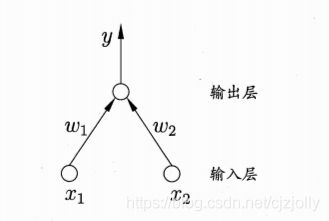AI入门笔记——感知机
概念:
有时候,我们需要分类一些东西,如分别一副图像是不是人脸,分辨一段波形是否为“拍照”,这些数据很多时候有无数变量,即无数维,要通过人脑建模对其进行分辨是非常困难的。因此,才有了感知机模型,以极度精简而粗糙的方式模拟神经网络学习的过程——实际上,就是参数调整的过程。
神经细胞可以理解为这样的一个模型:
无数的不同强度的“神经脉冲”通过突触输入到“细胞”中,如果累积的强度超过阈值,就从自己的“树突”中进行输出,否则则不输出。神经脉冲的波形可以抽象化为如下Sigmoid函数:
这里的“神经脉冲”可以抽象为一系列的输入(X1, X2 …… Xn),而“突触连接强弱程度”可以理解为每个输入对应的权重(W1,W2……Wn),用于确定其对应的输入信号在被细胞所接收的强弱程度,即(W1*X1,W2*X2……Wn*Xn),随后求和别输入到Sigmoid中,从而得到[0,1]范围的输出脉冲结果。
- 应用
现在大家一定很好奇这么个东西有什么用?那现在就用一个简单的例子来展示一下,就是让其自动实现“逻辑与”关系的建立。
首先我们定义一个模型:
这个模型分别有两个输入x1,x2,分别对应两个二进制输入变量,以及对应的权值w1,w2,输出结点有偏移值b = -1,现在我把w1,w2赋予随机数0.537372和-0.359797,此时分别输入[0,0] [0, 1] [1,0] [1,1]作为x1,x2,分别乘以权值w1,w2,求和后输入sigmoid函数,结果得到的脉冲数值分别为:
0.119203
0.086290
0.188066
0.139143
通过图像(颜色越浅值越大),我们也可以发现其分类方式实际有误,所有的输入的输出都在低数值区:
这可与预期结果[0, 0, 0, 1]差距深远,怎么办呢?
其实不难发现,基于sigmoid输出值和输入值的关系,我们可以通过调整权重的大小,来缩小脉冲输出和期望输出之间的差距。就像y=kx通过提高k值提高每个x对应y值的大小,而我们现在就是为了寻找合适的k值。
但因为激发函数Sigmoid不是y=kx,所以现在,我们要把误差作为指导,去通过夹逼方式修改对x1,x2两个脉冲的强弱接受度——即权重,来接近我们的期望输出,现在我们可以设脉冲输出为Yout,我们期望的输出为Ys,e为学习率——即夹逼过程的步进速率,我们可以得到dW = e * (Ys - Yout) * X1,即得到本次W1的更新量dW,此时通过W1 = W1 + dW,即完成了W1的一次步进更新,当dW接近或等于0时,代表输出Yout和预期Ys已经非常接近,即W1已经找到合适的权值使得实际输出与目标输出符合了。
迭代200次后,权值W1,W2被更新为1.460147,1.031295,可以从函数sigmoid(1.460147*x1+1.031295*x2-1)图像中发现,我们实现了与关系的分类,只有x1 = 1,x2 = 1在高亮度区域上:
- 总结
为何这么简单的问题要用如此复杂的方式解决?其实只是为了通过一个简单的例子说明,感知机是一种可以让机器自动根据输入输出对找到线性关系的方式,从而减轻人类负担的一种数学方法,也是BP神经网络等可以找到非线性关系的数学方法的基础。
实现代码
package com.cjz.lab.AILab;
import java.util.Random;
public class SensorMachine {
private static int input[][] = {{0, 0}, {0, 1}, {1, 0}, {1, 1}};
private static double standardOutput[] = {0, 0, 0, 1};
private static Random random = new Random(100000); //主要是对权值采取的是随机产生的方法
private static float etta = 0.02f; //学习率
public static void main(String args[]) {
Layer inputLayer = new Layer(2, 2);
Layer outputLayer = new Layer(2, 1);
for(int count = 0; count < 8000; count ++) {
System.out.println(String.format("weight[0] = %f, weight[1] = %f", outputLayer.mCell[0].mWeight[0], outputLayer.mCell[0].mWeight[1]));
double inputLayerResult[][] = new double[4][2];
double outputLayerResult[] = new double[4];
//forward
for(int i = 0; i < input.length; i++) {
inputLayer.input(new double[] {input[i][0], input[i][1]});
outputLayer.input(inputLayer);
inputLayerResult[i][0] = inputLayer.mCell[0].result;
inputLayerResult[i][1] = inputLayer.mCell[1].result;
outputLayerResult[i] = outputLayer.mCell[0].result;
//System.out.println("rr:" + String.format("%.6f", outputLayer.mCell[0].result)); //得出结果
}
//traning
for(int i = 0; i < standardOutput.length; i++) {
outputLayer.mCell[0].mWeight[0] += etta * (standardOutput[i] - outputLayerResult[i]) * input[i][0];
outputLayer.mCell[0].mWeight[1] += etta * (standardOutput[i] - outputLayerResult[i]) * input[i][1];
//????:
inputLayer.mCell[0].mWeight[0] += etta * (standardOutput[i] - inputLayerResult[i][0]) * input[i][0];
inputLayer.mCell[0].mWeight[1] += etta * (standardOutput[i] - inputLayerResult[i][0]) * input[i][0];
inputLayer.mCell[1].mWeight[0] += etta * (standardOutput[i] - inputLayerResult[i][1]) * input[i][0];
inputLayer.mCell[1].mWeight[1] += etta * (standardOutput[i] - inputLayerResult[i][1]) * input[i][0];
}
}
for(int i = 0; i < input.length; i++) {
outputLayer.input(new double[] {input[i][0], input[i][1]});
System.out.println("rr:" + String.format("%.6f", outputLayer.mCell[0].result)); //得出结果
}
}
private static class Layer {
public int mCellCount;
public int mInputCount;
public double mInputVal[];
public Cell mCell[];
public Layer(int inputCount, int cellCount) {
this.mInputCount = inputCount;
this.mCellCount = cellCount;
this.mCell = new Cell[cellCount];
for (int i = 0; i < this.mCell.length; i++) {
this.mCell[i] = new Cell(inputCount);
}
}
public Cell getCell(int index) {
return mCell[index];
}
public void input (double inputVal[]) {
mInputVal = inputVal.clone();
double sum = 0;
for (int i = 0; i < this.mCellCount; i++) {
for (int j = 0; j < inputVal.length; j++) {
sum += inputVal[j] * this.mCell[i].mWeight[j] + this.mCell[i].mBias;
}
this.mCell[i].result = sigmoid(sum);
sum = 0;
}
}
public void input (Layer prevLayer) {
mInputVal = new double[prevLayer.mCell.length];
for (int i = 0; i < prevLayer.mCellCount; i++) {
mInputVal[i] = prevLayer.mCell[i].result;
}
double sum = 0;
for (int i = 0; i < this.mCellCount; i++) {
for (int j = 0; j < prevLayer.mCellCount; j++) {
sum += prevLayer.mCell[j].result * this.mCell[i].mWeight[j] + this.mCell[i].mBias;
}
this.mCell[i].result = sigmoid(sum);
sum = 0;
}
}
}
private static class Cell {
public double mWeight[];
public double mBias;
public double result;
public Cell(int weightCount) {
mWeight = new double[weightCount];
//记得赋随机数给他们
for (int i = 0; i < weightCount; i++) {
double real = random.nextDouble(); //随机分配着产生0-1之间的值
mWeight[i] = random.nextDouble() > 0.5f ? real : -real;
}
mBias = -1f;
}
}
public static double sigmoid(double x) {
return 1 / (1 + Math.exp(-x));
}
}




